Innogy Plc Plan
for Hydro-Electric Scheme
at Romney Lock, Windsor
Thamesweb are grateful
to RWE npower for permission to reproduce this information and
pictures on The Royal Windsor Web Site.
Graphics ©RWE npower
There is a discussion area for this project here
Updates
Dec 2007 It seemed that
this project had been abandoned.
May 2008 A Planning Appication
has been lodged for a revised scheme. Discussion
area here
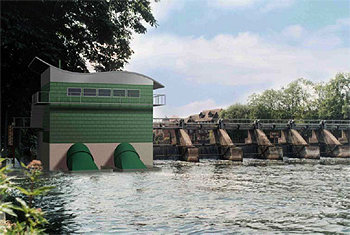
The original artist's
impression of the hydro-electric scheme at Romney Weir. This
has since been amended. see below.
We usually associate hydro-electric
schemes with giant dams and flooded valleys extending for hundreds
of miles so it comes as a pleasant surprise to hear of an innovative
scheme to supply power to Windsor Castle from the river that
flows by its doors. Modern technology now makes it possible to
harness the normally placid flow of the Thames by means of a
discrete turbine house which could generate enough power to satisfy
the needs of the Castle via an underground cable.
Even though the fall from the 'upstream' Windsor
reach of the river, to the downstream reach below Romney is only
four feet, that difference in height is apparently sufficient
to generate significant electrical power and with the government's
ambitious target that by 2010, 10% of the country's electricity
should come from clean, renewable sources of energy, Windsor
has a source of just such clean energy readily to hand. In fact,
for over 70 years, the energy at Romney Weir in Windsor was used
by hydro-turbines at Tangier Island to pump water to communities
on both sides of the river.
Romney Weir is almost unique in that it has more
gates than it currently needs such that not all the gates can
be opened at once. If they were, the reaches downstream would
be unable to cope. In addition, the constriction that is Windsor
Bridge could not supply that amount of water either.
Innogy plc (formerly known as National Power) is
proposing to install a small hydro-plant that would be capable
of generating 200kW of electrical power, providing 1.3 million
units of electricity to be supplied to Windsor Castle, a pioneering
'first' in the south-east of England although many such projects
have been undertaken in France and Germany.
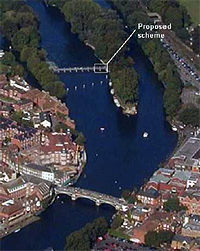 The location of
Romney Weir, with the proposed location of the hydro-electric
system.
The location of
Romney Weir, with the proposed location of the hydro-electric
system.
Windsor Bridge is at the bottom of the picture, and Romney Lock
Cut to the right
The proposed
project would feature a turbine in each of the last two weir
bays. Each turbine would drive an electrical generator to produce
100kW of electricity, which will be fed through a buried cable
up to Windsor Castle. The turbines would be enclosed in a small
building and any noise produced by the machinery would be fully
contained.
This is a relatively small project for this size
of river. The turbines will draw an average flow of 10 cubic
meters per second (m3/s - cumecs) and a maximum of 14m3/s. The
average flow in the Thames at this point is 56m3/s. Fine metal
grills will be inserted at both the intake and outfall of the
turbines so as to exclude fish and debris.
Flooding and other impacts
of the scheme
All aspects of the scheme
have been carefully considered to avoid any impact on residents
or river users. More information is available at the Eton Town
Council Offices, or by contacting RWE nPower.
Romney Weir is one of the largest weirs on the Thames.
Even though it has 10 sluice gates,
local residents may have noticed that the weir becomes flooded
(so that the fall over the
weir disappears completely) when only 6 gates are open. This
happens because the river
downstream of Romney is 'full' i.e. it cannot discharge flow
any quicker. When this happens,
opening more gates at Romney Weir cannot release any greater
flow from upstream to
downstream.
In very high flows, the water level will rise at
Romney as it has always done, but if the weir
is fully flooded, opening more gates cannot reduce the water
level. A flooded weir behaves
like any another part of the river channel. An analysis of gate
openings at Romney in high
flow conditions clearly demonstrates that opening more than 6
gates at Romney has no
effect on water levels. In other words, Romney Weir has more
sluice gates than it needs to
discharge even very high flows. Using 2 of the 4 surplus gates
for hydro-generation enables
part of the unused section of the structure to be utilised for
a positive benefit.
Boat-users and navigation
- The upstream and downstream
water levels will not be affected by the scheme.
- Access to the weir by
boat is forbidden and prevented by piles and cross-chains.
- The intake to each turbine
is protected by a grill, so anyone in the water cannot be drawn
into the turbines.
- The same amount of flow
is approaching the weir as before, so the scheme will not cause
any additional currents towards the weir.
- The lock cut and the lock
itself will not be affected in any way.
- Flows taken down the Eton
mill race, used occasionally as a canoeing course, will not be
affected.
Fisheries and angling
- Formal angling points
will be unaffected by the scheme.
- Fish screens upstream
and downstream will ensure mature fish are not taken into the
turbine. Additionally, an eel pipe will also be incorporated
to ensure safe passage for eels.
- The operation of the fish
pass and side spillway will not be affected.
- Juvenile fish such as
coarse fish fry small enough to pass through the screen will
pass through the turbine with minimal effect on mortality.
- The Environment Agency
has allocated three years of research funding in order to monitor
the fisheries impacts of the scheme. This is expected to start
in parallel with scheme commissioning in 2003.
Local ecology
- Environmental studies
have been undertaken to consider the potential impact of the
scheme on the local terrestrial, aquatic and geomorphologic forms.
- The scheme will utilise
less than 20% of the Thames average flow.
- The only change experienced
by this flow is that it passes through the turbines rather than
over the weir. A wetting flow will be maintained over the weir
at all times.
- Water Quality will remain
unaffected, the operation of the turbines will not result in
any
additions to the water flowing through them. In the event of
an accidental leakage, any oils used will be bio-degradable
Visual impact
 The weir before
construction looking upstream
The weir before
construction looking upstream
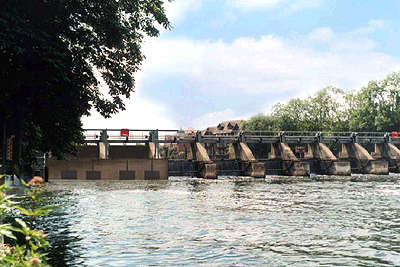
A revised artist's
impression of the weir following construction of the hydro-electric
facility
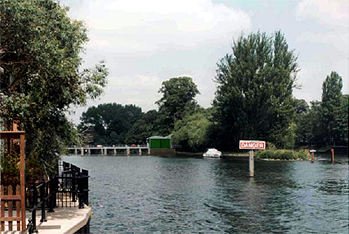
An artist's impression
of the installation from the Eton bank, looking downstream.
This has since been revised and may now be rather smaller.
Noise
- Acoustic measurements
were taken around the site at Romney by a specialist team, and
compared with measurements taken at an identical turbine operating
in France.
- Background noise levels
outside nearby residences were found to be relatively high even
at night over 50 decibels (dB(A)). Projected noise levels at
80 m distance (closest residential area at Eton Bank Court) are
relatively low at 38 dB(A). In other words, no noise impact is
expected.
Local disruption during
construction
- The time required to complete
the in-river works has been estimated at 16 weeks including contingency.
The total period of construction and commissioning of the plant
will be approximately six months.
- Access and transportation
will primarily be via the upstream river using barges to Romney
Island. Workmen will access the site by using the public footpath.
It is estimated that only about six people are likely to be working
at the site during the construction process at any one time.
- The working area will
be limited to a piece of fenced off land at the end of the weir
on Romney Island, owned by the Environment Agency. It will not
impinge upon public use of the towpath, nor prevent access to
mooring points upstream of the weir and will not be accessible
to the public.
- Work will be limited to
daytime periods only, pumps and generators will be fitted with
appropriate silencers and acoustic hoods (in accordance with
BS5228) as necessary.
Feedback
As the first such project
on the Thames, Innogy is keen to set a good example of the potential
that hydropower can play on the UK's lowland rivers, especially
in built-up areas. Innogy would welcome feedback on the project
and any questions or concerns on the scheme,
or any comments that may be able to improve the project, should
be addressed to Alastair Gill at:
Innogy Plc.,
Innogy Hydro
Dolgarrog Power Station
Dolgarrog, Nr. Conwy
North Wales, LL32 8QE
Tel: 01492
660811
This project was initially
co-funded by the European Commission.
First Green Light for
Windsor Castle Clean Power Scheme
Planning permission has
now been granted for this project to go ahead. On 12th February
2004 Innogy Plc., released the following:
Yesterday evening, a unique
hydro scheme moved one step closer to providing clean electricity
for Windsor Castle all supplied by the power of the River
Thames.
RWE Innogy, through its hydro business, is delighted
to have received outline planning consent to install a 200kW
hydro-electric scheme at Romney Weir at Windsor.
The project would be the first of its kind in the
south of England and would generate environmentally friendly
energy from the flow of water over an existing Thames weir.
It is intended that the electricity generated would
be exported to Windsor Castle. This would provide the Royal Household
and tourist attraction with electricity generated without the
production of carbon dioxide associated with global warming and
climate change.
The next stage of the project will be to finalise
details of the design of the powerhouse which will enclose the
turbine and associated equipment. RWE Innogy are currently completing
the consultation process which has included incorporating feedback
received from local residents and other interested parties such
as the Environment Agency. Careful consideration is also being
given to the materials and colours used to construct the turbine
enclosure to enhance its appearance.
The scheme would be adjacent to the bank of Romney
Island but almost invisible from public footpaths on both Romney
Island and Windsor Bank.
Alastair Gill, Hydro Development Manager, RWE Innogy,
commented that, "This is an exciting environmentally friendly
project and will provide enough clean energy to meet around a
third of the electricity needs of the castle. It will also offset
approximately 600 tonnes of carbon dioxide every year which would
otherwise have been released in to the atmosphere from the burning
of conventional fossil fuels. Today's announcement brings the
project one step closer to being a reality."
RWE Innogy is a leading UK renewable energy developer.
It develops and operates both wind and hydro-electric plants.
RWE Innogy currently operates nine hydro-electric power stations
in Scotland and Wales with a total combined capacity of 50MW.
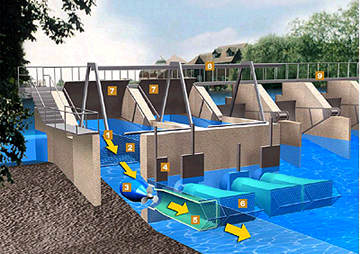
1. Arrow represents water flow through
the scheme.
2. Debris and fish screen to prevent
upstream wildlife and rubbish from getting to the turbines. The
screen is automatically cleaned to ensure clear a passage for
water.
3. Submerged hydro-electric propeller
turbines, each generating around 50kw of electricity, transferred
to Windsor Castle through insulated cables.
4. Penstock gates to control the volume
of water flowing through each turbine. Open when turbine is running,
closed when turbine is shutdown.
5. Draft tubes, designed to aid smooth
water flow back into the Thames..
6. Screens - prevent downstream wildlife
from swimming up into the turbines.
7. Existing weir gates, raised to
allow water to reach the turbines.
8. Extendable lifting gantry - used
to lift equipment from barges in and out of weir bays.
9. Existing walkway, authorised access
only.
July 2005
Final permission has been
given for a £1m, 200kw, hydro-electric power plant to supply
Windsor Castle with around one third of its electricity needs.
A Buckingham Palace spokesman said: "We're constantly looking
at ways of saving energy such as energy efficient light bulbs."
Four turbines are to be installed, built by Npower
Renewables, in two bays of Romney Weir. The installation will
be virtually invisible and very quiet and is expected to be completed
and on-line before the end of 2006.
Alastair Gill, Hydro Development Manager for Npower
renewables, said, "This is great news. We have worked hard
on the project to get it to this stage and its fantastic to receive
the go-ahead. As well as being carefully designed to fit into
the surroundings, by using the existing weir, the project will
have little impact on the ecology, navigation and marine life
of the river. With the weir shown to be more than adequate to
cope with the flow of water along this stretch of the Thames,
the hydro scheme will also have no effect on flood control measures."
A spokesperson from the Royal Household said, "We
have a policy of introducing and maintaining energy-efficient
practices wherever possible. Consent for the Romney Weir Hydro
Scheme is a major contribution."
Tim Reeder, Climate Change Regional Project Manager
(Thames) at the Environment Agency said, "We are always
supportive of initiatives which can help reduce the impacts of
climate change and have taken account of their local environment.
The Environment Agency are keen to further investigate opportunities
for hydropower, and are pleased to see this project finally come
to fruition".
The next step is to run a feasibility study to better
understand how to build the scheme. All being well construction
is expected to begin next year, with Windsor Castle due to receive
green electricity before the end of 2006.
General information about
Romney Weir Hydro scheme can be found on the npower renewables
web site at www.npower-renewables.com
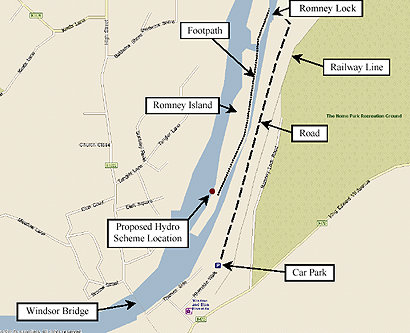 Location Map
Location Map
|

